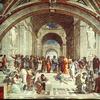The recent advances of AI technology, particularly in AI-Generated Content (AIGC), have enabled everyone to easily generate beautiful paintings with simple text description. With the stunning quality of AI paintings, it is widely questioned whether there still exists difference between human and AI paintings and whether human artists will be replaced by AI. To answer these questions, we develop a computational framework combining neural latent space and aesthetics features with visual analytics to investigate the difference between human and AI paintings. First, with categorical comparison of human and AI painting collections, we find that AI artworks show distributional difference from human artworks in both latent space and some aesthetic features like strokes and sharpness, while in other aesthetic features like color and composition there is less difference. Second, with individual artist analysis of Picasso, we show human artists' strength in evolving new styles compared to AI. Our findings provide concrete evidence for the existing discrepancies between human and AI paintings and further suggest improvements of AI art with more consideration of aesthetics and human artists' involvement.
翻译:近年来,人工智能技术尤其是AI生成内容技术(AIGC)的发展,使每个人都能通过简单的文字描述轻松地生成美丽的绘画作品。由于AI艺术作品的惊人质量,广大群众普遍质疑人类与AI绘画之间是否仍然存在差距,以及人类艺术家是否将被AI取代。为回答这些问题,我们开发了一个计算框架,将神经潜空间和美学特征与可视分析相结合,以研究人类与AI绘画之间的差异。首先,通过对人类和AI绘画作品集的分类比较,我们发现在潜空间和诸如笔触和锐度等某些美学特征上,AI艺术作品与人类艺术作品存在分布差异,而在其他美学特征(如色彩和构图)上,差异较小。其次,通过对毕加索的个体艺术家分析,我们展示人类艺术家在演变新风格方面的力量,相较AI更胜一筹。我们的发现为人类和AI绘画之间的现有差异提供了具体证据,并进一步暗示了通过更多考虑美学和人类艺术家的参与来改进AI艺术的方法。


